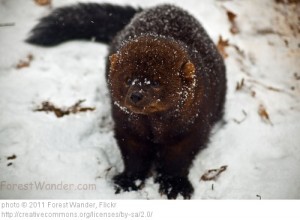Hopefully the past few weeks have provided some new insight into an impressive and, at least in the Northeast, common predator. Fishers aren’t abundant in all parts of their range, but they are active members of the community where I live, and information provided by Dr. Kays’ research, as I mentioned last week, indicates they are learning how to make urban areas livable- this suggests they are going to be features of the landscape for the foreseeable future.
Why is this a good thing? As I said before, fishers are generalist predators who help control porcupine populations, which is good for the timber industry. According to NH Fish and Game fishers also help limit vole and mice populations in NH, tempering prey cycles and reducing their impact on vegetation. The fact that fishers eat squirrels and other seed hoarders can be important for seed dispersal- when the animal who created the seed cache dies before eating the seeds, those seeds are left to germinate, often in areas away from the original tree. Dr. Kays (2011) noted that urban fishers ate more gray squirrels than rural fishers- that’s probably good for quite a few acorns, pine cones, and other nuts out there.
There are no fishers in my area, so how does this apply to me? One of the big things to consider about smaller carnivores is that they are gaining influence in some areas precisely because they aren’t large. As our landscapes become more fragmented by roads and housing developments and other construction, it is increasingly difficult for large carnivores, like mountains lions and bears, to continue meeting their needs in human-altered environments, and this opens up new opportunities for mesocarnivores, like fishers and foxes. The impact of these changes can be positive and/or negative depending on who you ask, but this does seem to be the trend for urban/suburban carnivore communities. I highly recommend Roemer et al. (2009) for more detail on how small carnivores contribute to ecosystems and how those roles have been changing- I’ve provided a very, very brief summary of those ideas in this posting.
What can you do?
There are a few ways that you can directly and indirectly contribute to the continued presence of fishers and other small carnivores in the ecosystems around you:
- In terms of your physical environment, NH Fish and Game recommend maintaining a diverse forest cover with openings, dense patches, and dead/dying trees- a study in California (Zielinski et al. 2004) highlighted the importance of cavities in dead and dying black oak trees for fisher nesting sites. Wild apple trees are also favored by porcupines, one of the fisher’s main prey.
- If you are interested more in the research process and the subject animal isn’t so important to you, consider contacting a local biologist about volunteering- Dr. Kays is interested in working with community members and camera traps to record mammal data, and other scientists have similar programs.
- Talk to people about the importance of small carnivores in a healthy ecosystem. I’m not suggesting that everyone should think of fishers as cuddly bundles of love- they are fierce predators. But they do play an important role in a variety of environments. Research suggests that people have more negative and fearful attitudes toward carnivores when those predators are unfamiliar or new (Hudenko et al. 2010). So, hopefully, the more people understand about how fishers contribute to a resilient ecosystem, the more willing they will be to share space with them. Factual publicity may be exactly what fishers need.
Over the past few weeks, I’ve looked at fisher research, past and present- I’m still hoping to see one in the wild, but, in the meantime, I’ll continue to work for their public image. And, even if you don’t have fishers in your area, maybe there are other mesocarnivores that could benefit from an improved reputation. 
Works cited:
Hudenko, H.W., W. F. Siemer, and D.J. Decker. 2010. “Urban carnivore conservation and management” in Urban Carnivores: Ecology, Conflict, and Conservation. S.D. Gehrt, S.P.D. Riley, and B.L. Cypher, eds. Baltimore: Johns Hopkins UP.
Kays, R. “Do fishers really eat cats?” The New York Times on-line Scientist at Work Blog. April 6, 2011.
Roemer, G.W., M.E. Gompper, and B. van Valkenburgh. 2009. The ecological role of the mammalian mesocarnivore. BioScience 59(2): 165-173.
Zielinski, W.J., R.L. Truex, G.A. Schmidt, F.V. Schlexer, K.N. Schmidt, and R.H. Barrett. 2004. Home range characteristics of fishers in California. Journal of Mammalogy 85(4): 649-657.
